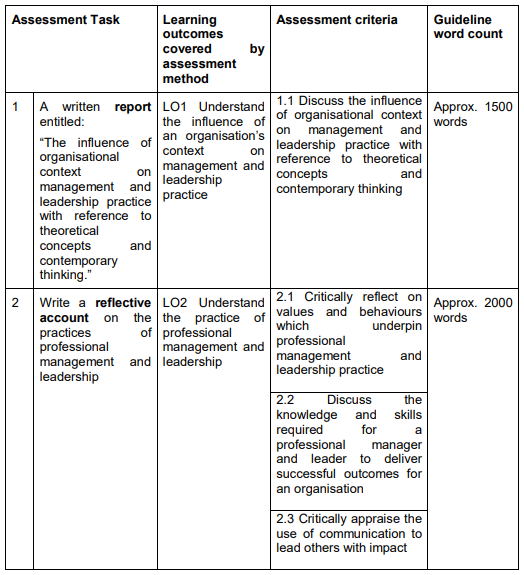- CIPD level 5HR02 Assignment: Talent Management and Workforce Planning Unit Guide
- Level 3 D/615/3823 Assignment: Regulation, Protection, and Collaborative Practice in Health and Social Care
- ILM Level 4 Assignment 01: Developing Leadership Styles: An Action Plan for Effective Leadership and Team Engagement
- Level 6 Unit T/615/2726 Assignment: Strategic Project Management: Identifying, Planning, and Controlling Projects for Business Success
- EDD-U1-T4 Assignment: Internal and External Support Services for Educational Practitioners
- Discussion Paper on Market Forces and Government Interventions for Business Leaders
- Unit 10 Customer Relationship Management Assignment – CRM Processes & Stakeholder Roles
- CIPD 7HR02 Resourcing and Talent Management to Sustain Success
- Athe Level 3 Health and Social Care Assessment Questions
- M/618/4168 Unit 2 Principles, Values and Regulation in the Health and Social Care Sector – ATHE Level 3
- ILM Communication Skills Self-Assessment
- ILM Unit 8600-309: Understand How to Establish an Effective Team
- CMI Unit 525 Using Reflective Practice to Inform Personal and Professional Development
- Understand and Work with a Wide Range of Stakeholders and Organisational Structures – Assignment 1
- Assessment: Financial Performance Evaluation of Savory Snacks Company Ltd for Credit
- CMI L5 Assignment: Managing Stakeholder Relationships: Strategies, Challenges, and Best Practices
- Level 3 Unit 2 Assignment: Principles, Values and Regulation in the Health and Social Care Sector
- COM4006 Assignment: Introduction to Academic Skills and Professional Development
- Assessment: Managing Organisational Change: Evaluating Strategies, Challenges, and Impact
- UNIT CMI 706 Assignment: Finance for Strategic Leaders: The Role, Scope, and Impact of Finance
CMI 504 Assessment: The Rationale For Managing Performance Within Organisations
| University | University of Oxford (UO) |
| Subject | CMI unit 504:managing performance |
Overview of assessment tasks
Each task in this assessment brief has been developed to enable you to evidence achievement of the learning
outcomes and assessment criteria for CMI 504: Managing Performance. Each of the assessment criteria must
gain a pass outcome for you to successfully achieve the unit.
Preparation for the assessment
● Before you begin the assessment brief please read the CMI 504 unit specification thoroughly as only the
content related to the achievement of the assessment criteria will be assessed.
● Research the topics being assessed. Suggested reading/web resources are provided on the CMI 504 unit
specification. Your tutor may signpost you to relevant resources. Additionally, you may access excellent online
resources at ManagementDirect https://members.md.cmi.org.uk. Please note that if you have a customised site the
link will differ, please contact your Centre for clarification.
● If you are enrolled on the Trailblazer Apprenticeship programme you are encouraged to review the
Apprenticeship Standard for Operations/Departmental Manager.
Completing the assessment brief
● The assessment brief contains a series of tasks which are clearly referenced to the relevant assessment
criteria and indicative content.
● Refer to the Assessment Guidance Table at the end of the assessment brief which outlines the requirements
for a Pass or Refer.
● Evidence must be provided in the evidence booklet. Additional work based evidence such as plans or
documentation (which has been referred to within the main text) should be included at the end of the booklet
marked ‘Work Based Evidence’. Appendices are not a requirement of this assessment brief. If appendices are
included these will not be marked or moderated by the CMI.
● Work based evidence must be accompanied by a supporting statement in the learner evidence box, to explain
the link to the assessment criteria. Work based evidence (where required by the task) must not exceed SIX (6)
pages. Files embedded in the booklet must not exceed 10MB.
● The evidence booklet must be completed in a professional manner (e.g. applying business conventions for
writing formal reports) and by using Microsoft Word, Rich Text Format or another compatible software
programme and not in a PDF format.
● An appropriate referencing system (such as Harvard Referencing) must be used to ensure the original
source(s) of quotations or models can be verified.
● Finally, you must sign the Learner Authenticity statement (an electronic signature is accepted).
Learner support For information regarding policies and procedures for assessment (e.g. special assessment arrangements, learner
support, appeals, complaints, certification, confidentiality, plagiarism) you should contact your tutor or Centre
manager and refer to the CMI Level 5 in Management and Leadership syllabus.
INTRODUCING ASSESSMENT BRIEF CMI 504
Managing the performance of staff is essential to the smooth running of an organisation.
Assessment brief CMI 504 has been designed to evaluate the reasons for managing performance and the
approaches that can be used. It explores methods of rewarding the performance of individuals who exceed
expectations, and analyses ways of managing under performance in a professional and supportive manner. This
unit focuses on the way performance management, when used effectively, is able to impact on individual and
organisational achievement.
ASSESSMENT TASKS AND WORD COUNT
Assessment brief CMI 504 features the following assessment tasks. Further detail is provided against each
assessment task within the brief.

Guideline word count:
The written word, however generated and recorded, is still expected to form the majority of assessable work
produced by Learners at Level 5. The amount and volume of work for this unit should be broadly comparable to a
word count of 3000-3500 words within a margin of +10%. The excessive use of word count is not grounds for
referral, however the CMI reserve the right to return work to the Centre for editing and resubmission by the
Learner.
The following are excluded from inclusion in word count, if used and not required by the assessment brief an
introduction to a job role, organisation or department, index or contents pages, headings and sub headings,
diagrams, charts and graphs, reference list or bibliography, reflective statement drawn from undertaking the
assignment and how this has impacted on the learner’s work.
Please see the CMI Assessment Guidance Policy for further guidance
Do You Need Assignment of This Question
THE RATIONALE FOR MANAGING PERFORMANCE WITHIN ORGANISATIONS
When implemented effectively, performance management best practices result in a wide range of benefits for the
organisation, managers and employees alike.
TASK 1
Write a compelling account using examples to justify the rationale for managing performance within organisations
(AC1.1).
Guidance for completion of Task 1
● The account must include sub headings. You may choose to include tables and diagrams (as appropriate) to
support your discussion.
● You are encouraged to consider your own experience of managing performance within organisations or the use
of good practice examples from an organisation you know well or have researched.
● Please refer to the indicative content for each of the assessment criteria (AC) outlined in the unit specification.
FRAMEWORKS, DIAGNOSTIC AND EVALUATION TOOLS USED FOR PERFORMANCE
MANAGEMENT
It is essential to understand the impact of legal and organisational frameworks, and the tools that can be used to
support performance management in organisations.
TASK 2
Using well chosen examples, write a report entitled ‘Frameworks, diagnostic and evaluation tools used for
performance management’.
The report must:
i. Examine the impact of TWO (2) organisational and ONE (1) legal framework on performance management
(AC2.1)
ii. Evaluate TWO (2) diagnostic and evaluation tools which support performance management (AC2.2)
Guidance for completion of Task 2
● Base your response on your own experience of using frameworks, diagnostic and evaluation tools to manage
performance or use well chosen examples from an organisation you know well or have researched.
● The report must include sub headings. You may choose to include tables and diagrams (as appropriate) to
support your discussion.
● Important note: You are not required to examine the impact of all legal and organisational frameworks on
performance management. You should focus on a minimum of TWO (2) organisational and ONE (1) legal
framework which you feel are essential to the task.
● Refer to the indicative content for each of the assessment criteria (AC) outlined in the unit specification.
MANAGING PERFORMANCE
Performance has to be managed if individuals are to develop, maintain or improve their knowledge, skills and
behaviours. It is not always an easy task.
At one end of the spectrum, individuals who exceed expectations need to be managed effectively so that they are
able to maintain their performance and do not lose momentum. In contrast, individuals who consistently fail to
achieve their targets or exhibit unsatisfactory behaviour will need to be managed in a structured way to improve
their professional practice.
Buy Answer of This Assessment & Raise Your Grades
SCENARIO
You work as a manager for an operational department in a large organisation which has ambitions to gain recognition
as a ‘Top 100 UK Employer’.
The organisation has a loyal workforce and a low staff turnover, but there is an increasing rise in performance issues
among the staff team.
An in-depth review of human resource management practices and results of a staff survey have identified a number
of issues
a. The need for managers to consistently apply good practice principles for performance management with special
regard to making evidence based judgments, being fair to all (impartial), taking proportionate actions
b. There are increasing incidents of underperformance from some members of the team, for which the causes are
not always known or understood
c. Managers have raised concerns over the challenges of managing underperformance of team members, such as:
having a lack of knowledge or understanding of the processes for performance management; trying to maintain
business continuity when underperformance occurs; dealing with the emotional aspects of performance
management (for example, alienation from colleagues, anger from staff who have been told that their
performance does not meet the required standard)
d. The need to develop and manage individuals that consistently exceed expectations (especially when
opportunities for promotion are limited).
TASK 3
Basing your response on the scenario on page 5, your own experience of managing performance in organisations
or using well chosen examples from an organisation you know well or have researched:
Create a good practice guide entitled ‘Practical approaches for managing performance in the workplace’. The
good practice guide will be used to equip other managers with an understanding of how to manage performance in
a professional manner and ensure that all staff are managed effectively.
The good practice guide must be presented in FIVE (5) sections:
A. Good practice principles for managing performance
To complete this section of the good practice guide, you are required to use examples to:
i. Discuss good practice principles for managing performance (AC3.1)
B. Formal processes for managing performance
To complete this section of the good practice guide, you are required to use examples to:
i. Examine THREE (3) formal processes for managing performance (AC3.2)
C. Signs and causes of underperformance
To complete this section of the good practice guide, you are required to use examples to:
i. Analyse the relationship between signs and causes of underperformance (AC3.3)
D. Approaches used to respond to challenges to managing underperformance
To complete this section of the good practice guide, you are required to use examples to:
i. Evaluate approaches to respond to THREE (3) challenges when managing underperformance (AC3.4)
E. Techniques for developing and managing individuals who exceed expectations
To complete this section of the good practice guide, you are required to use examples to:
i. Recommend TWO (2) techniques for developing and managing individuals who exceed expectations (AC3.5)
Guidance for completion of Task 3
● Base your response on the scenario on page 5, your own experience of managing performance in
organisations or use well chosen examples from an organisation you know well or have researched.
● The good practice guide must be written using the sections identified within the brief. You may choose to include
tables and diagrams (as appropriate) to support your discussion.
● You may include reference to relevant theoretical principles/models/frameworks as appropriate.
● Please refer to the indicative content for each of the assessment criteria (AC) outlined in the unit specification.
Are You Looking for Answer of This Assignment or Essay



